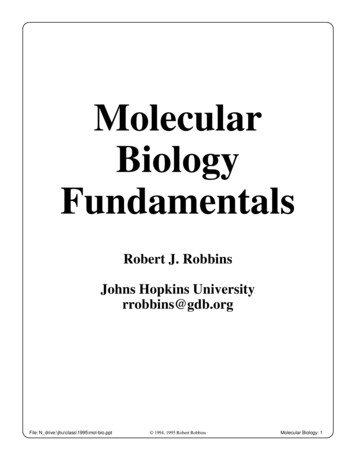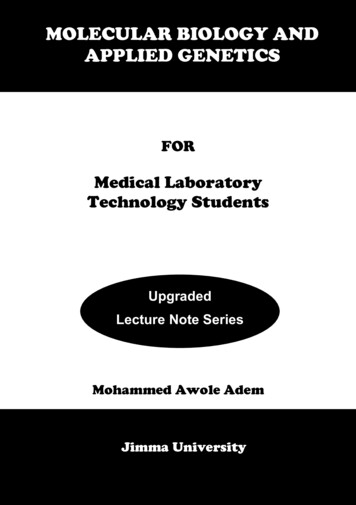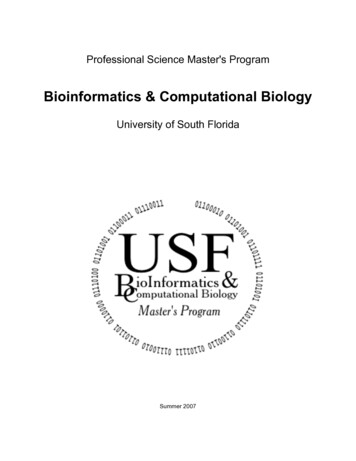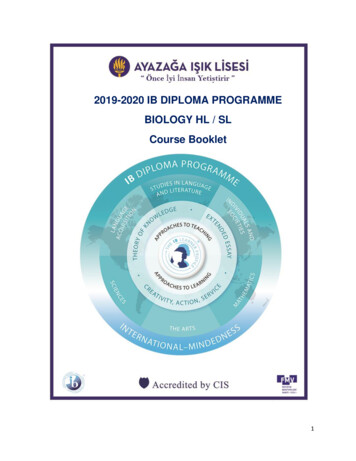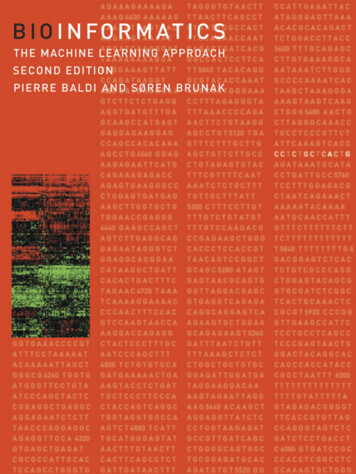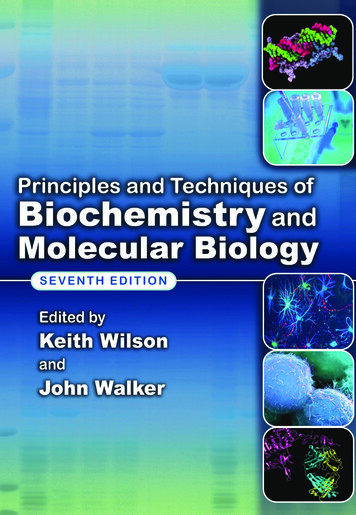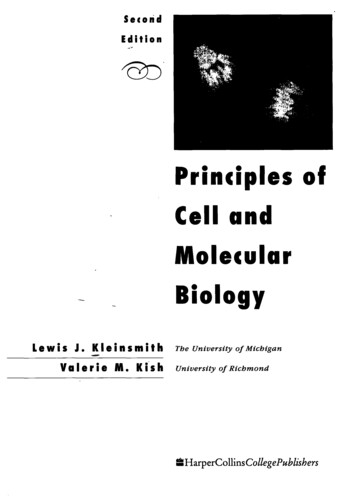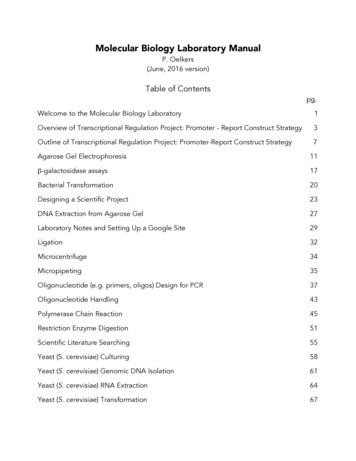
Transcription
Molecular Biology Laboratory ManualP. Oelkers(June, 2016 version)Table of Contentspg.Welcome to the Molecular Biology Laboratory1Overview of Transcriptional Regulation Project: Promoter - Report Construct Strategy3Outline of Transcriptional Regulation Project: Promoter-Report Construct Strategy7Agarose Gel Electrophoresis11β-galactosidase assays17Bacterial Transformation20Designing a Scientific Project23DNA Extraction from Agarose Gel27Laboratory Notes and Setting Up a Google igonucleotide (e.g. primers, oligos) Design for PCR37Oligonucleotide Handling43Polymerase Chain Reaction45Restriction Enzyme Digestion51Scientific Literature Searching55Yeast (S. cerevisiae) Culturing58Yeast (S. cerevisiae) Genomic DNA Isolation61Yeast (S. cerevisiae) RNA Extraction64Yeast (S. cerevisiae) Transformation67
Welcome to the Molecular Biology LaboratoryScience can be defined in a variety of ways. Science may be the construction of rulesand relationships that define a world that matches our world as closely as possible.Science may the acquisition of knowledge through information collection and analysis. Inany case, science involves learning. It involves taking what is known and expanding andrefining that knowledge. While science it rooted in work already done, its branchesstretch out into a seemingly endless sky. Scientists are explorers who go beyond what itis currently known.With these lofty ideals in mind, each group of two or three students will be conductingan independent research project during the course of the term. In the education field,this is called experiential learning or inquiry-based learning. A framework for theprojects will be suggested. This framework was chosen so that a variety of techniques areemployed, the logistics are feasible, and planning can be completed in two or threeweeks. Projects involving molecular biology outside the proscribed framework arepossible. Please discuss such projects with the instructor prior to initiation.As in any project, a goal-centered approach and attitude will be required. To put itsimply, get it done, well. If a certain experimental step in unsuccessful in achieving theexperimental goal, that step will have to be repeated or an alternate strategy adopted.Progress will require careful, expedient, and productive work. Such a goal-centeredapproach and attitude are also required in many professional settings. Few professionalsare paid to take tests. Accordingly, your evaluation will primarily be based on theprogress of the project at the end of the term. To maintain a productive pace, substantialprogress should be make each week. This will require self-motivation and discipline. Inthe words of a very successful basketball coach, John Wooden, “Move quickly but do notrush”. This pace may benefit from one or more group members coming to the lab ondays and at times beyond scheduled class meetings. Due to the use of the laboratory forthe instruction of other classes, the possible days and times will be limited and requireadvanced scheduling.All of this may seem daunting. Exploration involves the unknown. There is no gettingaround that. However, taking your knowledge and skills and applying them to a goal willhopefully be an enriching experience. Eleanor Roosevelt is quoted as saying, “You gainstrength, courage and confidence by every experience in which you really stop to lookfear in the face. You are able to say to yourself, ‘I have lived through this horror. I can takethe next thing that comes along.’ You must do the thing you think you cannot do.” Ofcourse, the aim is for this course to stop well short of horror. The aim is also to have skills1
to support the confidence for facing the unknown. When confidence and competencecome together, great things may be achieved.Please appreciate that this laboratory manual does not provide information in theorder in which it will be needed (i.e. week 1, week 2 ). The manual is instead acollection of protocols for performing techniques that will likely be part of your project.The suggested schedule of experimental steps on the following page (also in thesyllabus), will indicate what protocol is needed at any given time. The reasoning behindthis manner of organization is that few professional references are custom tailored to asingle user’s needs. Instead, references are organized so that a myriad of users canreadily find what they need.Good luck! Please use the instructor as a resource whenever needed.2
Overview of Transcriptional Regulation Project:Promoter - Report Construct StrategyOur goal is to better understand transcriptional regulation by designing andconducting experiments involving the promoters of one or more genes. Saccharomycescerevisiae (Baker’s or Brewer’s yeast) will be used as a model system.Many advantages provided by S. cerevisiae make it a convenient model experimentalsystem Complete sequencing of the S. cerevisiae genome was achieved about 20 yearsago (4) and a well-annotated, on-line genome compendium (www.yeastgenome.org)facilitates bioinformatics efforts. Growth media components are commonly inexpensiveand strains readily available from principal investigators or the American Type CultureCollection (ATCC). Plasmid vectors with a range of origins of replication, promoters, andmarker genes are available for cloning or other modification using recombinant DNAtechniques.Rapid growth, high efficiency transformation, ease of environmentalalteration, and well established protocols round out the pragmatic benefits ofexperimenting with S. cerevisiae.While the power of yeast genetics potentiates screens to establish gene - functionrelationships, S. cerevisiae is also amenable to studies of transcriptional regulation.Nutrient availability, oxidation, temperature, osmotic environment, concentration ofmetals, radiation, agonists, and antagonists offer a variety of stimuli, some stressful, thatyeast may experience in nature. Each of these has been found to initiate in yeast aregulatory response with a transcriptional component (1, 2). Transcriptional changes alsooccur in response to fermentation byproducts such as acetic acid and furfural generatedduring commercial ethanol production (3).Analysis of the entire yeast transcriptome in response to environmental stimuli hasbeen performed using comprehensive microarrays and RNA sequencing (1). These dataare often available in the public domain linked to publications or within the annotatedgenome (www.yeastgenome.org). Accordingly, a good deal of information can be foundon-line about the transcriptional regulation of any gene of interest.One experimental strategy to examine transcriptional regulation of yeast gene(s) ofinterest is called the promoter - reporter method. This approach uses the polymerasechain reaction (PCR) to amplify the putative promoter region from S. cerevisiae genomicDNA. As for most PCRs, two specific oligonucleotides (i.e. primers or oligos) must bedesigned. The two oligos flank the region intended for amplification. Restriction3
endonucleotide recognition sequences may be incorporated into the oligos to facilitatesubsequent ligating into the reporter plasmid.Following the PCR, the products are resolved by agarose gel electrophoresis andpurified from the gel. Restriction enzyme digests then create “sticky ends” on the PCRproduct. Alternatively, vectors designed for ligating PCR products directly may be used.Identical digests of the reporter plasmid, pSF011 (5) that contains a β-galactosidasereporter gene allows for subsequent ligation of the PCR product and the digestedpSF011. Upon successful ligation, the promoter now may control transcription of theneighboring β-galactosidase gene.Following ligation, the reaction mixtures are incubated with carefully prepared labstrains of E. coli under conditions known to promote the uptake of exogenous DNA.These carefully prepared E. coli are known as competent cells and the process is calledtransformation. The transformation process is fairly inefficient such that the vast majorityof bacteria in a transformation do not take up the DNA of interest. Transformation canalso done with yeast but that process is orders of magnitude less efficient than going intobacteria first. To selectively allow only those bacteria which took up plasmid DNA togrow, the transformation mixtures are grown on agar plates that contain the antibiotic,ampicillin. pSF011 contains the β-lactamase gene that confers ampicillin resistance tocells that contain the plasmid. This way, the few bacteria that take up the plasmid willhave a selective growth advantage.Overnight growth on ampicillin containing plates allows cells that contain plasmids toproliferate and form a colony. Each colony presumable arose from a single cell that tookup one of the plasmids from the ligation reaction. There is a possibility that colonies arisefrom digested plasmid (e.g. pSF011) ligating upon itself without insertion of the PCRproduct. To address this possibility, parallel “control” ligation reactions are oftenassembled which contain all the components without the PCR product. The number ofcolonies generated from transforming these control ligation reactions will establish thebackground. Transformation plates with ligations that contain PCR products should haveat least twice as many colonies as plates with control ligations.Even if the desired ratio is observed, the insertion of the PCR product into pSF011 hasto be verified. Therefore, bacteria from a number of colonies (often eight) from the“plasmid PCR product” transformation plate are used to inoculate 5 ml of liquid mediawith ampicillin. This growth in liquid media is necessary to amplify the number ofbacteria and thus the mass of plasmids (around 10 µg from 5 ml). Following the growth,plasmids will be isolated from the bacteria using the alkaline lysis miniprep protocol. This4
plasmid DNA is then digested so to confirm its sequence. Planning this analytical digestrequires choosing restriction enzymes that will generate distinctly unique numbers and /or lengths of plasmid fragments if pSF011 has the insert or not. Agarose gelelectrophoresis in parallel to DNA size standards will allow the estimation of the digestedfragment sizes. If the banding pattern matches the expected pattern of the vector insert, a glycerol stock will be made of the bacteria so to allow future culturing of thosebacteria and the generation of more plasmid DNA.If time allows, the newly constructed plasmid will be submitted for DNA sequencing.One possibility that should be addressed is that during the PCR reaction the polymeraseintroduced a mispaired nucleotide into the product.Following generation of the pSF011 / promoter plasmids, the plasmid will belinearized by restriction enzyme digestion and purified. This will allow recombination withthe host yeast’s genome and integration. Lab strains of S. cerevisiae (yeast) will then betransformed with these plasmids. Transformation requires that the yeast cells be madecompetent or induced to take up exogenous DNA. This process involves growing yeastinto the logarithmic (i.e. log) stage of growth and suspending then in a mixture of ionsand detergents including lithium acetate and polyethylene glycol. Transformations areplated onto specialized yeast agar plates that lack the nutrient uracil.Only transformed yeast will grow in the absence of uracil. This is because the labstrains utilized have been selectively mutated so that the URA3 gene is non-functional.Without the protein made from the URA3 gene, the cells cannot synthesize uracil de novoand thus require it in the environment. However, pSF011 contains a functional copy ofURA3 and confers the ability to grow in the absence of uracil. After two days of growth at30 ºC, colonies should be present on the transformation plates.Transformed yeast are commonly streaked onto a new agar plate that lacks uracil.This “master plate” can seed cultures for experiments involving exposing yeast to variousenvironmental conditions. 5 ml cultures of yeast are often used for each condition. Afterthe planned length of exposure to the conditions (perhaps a time course will beperformed), yeast can be harvested, lysed, and β-galactoside reactions performed.Bar graphs are a common way the β-galactoside activities are reported. If time allows,the yeast can be cultured again, exposed to the conditions of interest, and the βgalactoside assays repeated.References5
(1) H. Taymaz-Nikerel, A. Cankorur-Cetinkaya, B. Kirdar (2016) Genome-WideTranscriptional Response of Saccharomyces cerevisiae to Stress-Induced Perturbations.Front. Bioeng. Biotechnol. 4, 17.(2) N.C. Bauer, A.H. Corbett, P.W. Doetsch (2015) The current state of eukaryotic DNAbase damage and repair. Nucleic Acids Res. 43, 10083-10101.(3) Y. Chen, J. Sheng, T. Jiang, J. Stevens, X. Feng, N. Wei (2016) Transcriptional profilingreveals molecular basis and novel genetic targets for improved resistance to multiplefermentation inhibitors in Saccharomyces cerevisiae. Biotechnol Biofuels. 9,9.(4) A. Goffeau, B.G. Barrell, H. Bussey, R.W. Davis, B. Dujon, H. Feldmann,F. Galibert ,J.D. Hoheisel, C. Jacq, M. Johnston, E.J. Louis, H.W. Mewes, Y. Murakami, P.Philippsen, H. Tettelin, S.G. Oliver (1996) Life with 6000 genes. Science. 274, 563-567.(5) Y.J. Joo a, J. Kim, J.H. Baek, K.M. Seong, J.Y. Lee, J. Kim (2009) Determination of thecore promoter regions of the Saccharomyces cerevisiae RPS3 gene. Biochim. Biophys.Acta 1789: 741-750.6
Outline of Transcriptional Regulation Project:Promoter - Report Construct StrategyI. Planning, stage 1 (to be completed by the beginning of the third class meeting)A. Choose a cell or physiological function or process of interest.B. Use prior knowledge and the scientific literature to identify three proteins in anyorganism that are components in that function or process.1. Be sure to keep a record of papers used. Save the pdf files if possible.2. Find a copy of the proteins’ amino acid sequence- www.ncbi.nlm.edu and the Protein tab may help with this- finding an accession number in a paper will also help- establish a file with protein amino acid sequences3. OR, use YeastMine do) tosearch for textwords related to the function or process in yeast gene descriptionsC. Use the blastp function at www.yeastgenome.org to search for a similar protein in theyeast proteome. Record the name of the yeast protein and the corresponding gene. Ifthis process does not identify at least two yeast genes, repeat steps B and C until atleast two yeast genes which encode for proteins with similar sequence to proteins inother organisms with established functions.D. Search the literature and the www.yeastgenome.org site for information about thetranscriptional regulation of the genes of interest. Make careful notes of the conditionswhich lead to the transcriptional regulation and the degree and direction of theregulation. Download pdf files of relevant papers when possible.E. Using previous and gathered knowledge, generate three hypotheses or formulatethree questions about the transcriptional regulation of each gene. Include amechanistic rationale that supports the hypotheses or gives the question importance.Include detailed logistics such as specific media compositions and comparisons thatwill be made. Along with the background information gathered, formally structure thisinformation into an experimental design that will be submitted and evaluated.7
II. Planning, stage 2 (to be completed by two days after the third class meeting so toallow the ordering of oligonucleotide prior to and PCR on the fourth class meeting)A. Determine the genomic (i.e. chromosomal) location of the open reading frames for thetwo genes of interest. Also determine the genomic location of the open reading frameof the nearest gene to the 5’ of the start codon of each gene of interest. Make a tableof these locations.B. From the table made in (1), determine the genomic / chromosomal location (i.e.beginning and end) of the putative promoter region of each gene of interest.C. Design oligos to amplify the complete, predicted promoter containing 5’ flankingregion of each gene of interest. Two, non-overlapping reverse oligos will be very closeto the start codon of the gene of interest and two, non-overlapping forward oligos willbe very close to the start or stop (whichever is closer) codon of the nearest neighbor.D. [optional] Design additional forward oligos that will only amplify a portion of theputative promoter, thus producing a truncation.E. At the 5’ of each oligo, include sequence that is the recognition sequence for arestriction enzyme that has no sites in the sequence of interest and has one site in thepolylinker of pSF011. Primers intended for use as pairs should have different restrictionenzyme recognition sequences. The goal is to digest the PCR product with therespective enzymes, digest pSF011 plasmid with the same two enzymes, gel-purify theproducts, and perform a ligation. The 5’ flanking sequence should have the sameorientation in the plasmid than it had in the genome.F. Add 8 nt of extra sequence to allow for optimal digestion with the respective restrictionenzyme.G. Post an Excel spreadsheet to your on-line lab notebook with a unique and informativename for each oligo and its sequence8
III. Execute the experimental plan, stage 1 (PCR and subcloning)- steps (1) are for generating and preparing the insert for the ligation- steps (2) are for generating and preparing the vector for the ligationA. Isolate genomic DNA and use this as the template with the appropriate oligo pairs in aPCR.B. Resolve PCR products by agarose electrophoresisC1. Verify that PCR products are the correct size and if so, purify PCR products from theagarose gelC2. Isolate pSF011 plasmid DNA from bacterial cultures grown overnightD1. Digest PCR products with the appropriate restriction enzymes so to createasymmetrical “sticky” ends.D2. Digest pSF011 plasmid DNA with the appropriate enzymes (as in 4a)E1. Resolve digested PCR products by agarose electrophoresis and purify.E2. Resolve digested PCR products by agarose electrophoresis and purifyF. Set up a ligation with each sticky-ended PCR product with the respective, sticky-endedpSF011 DNA. Ideally, three ligations will be done for each. Two of these will containboth pSF011 and PCR product. They will differ in regards to the amount of PCRproduct. The third ligation will only have pSF011 and no PCR product. This is thenegative control. Put ligation at 15 C (4 hours – 24 hours).G. Transform ligations into competent E. coli. Place transformation plates at 37 C forovernight growth.H. If the distribution of colonies is as expected, pick 8 colonies from the respective insert vector transformations and inoculated 5 ml LB ampicillin. Culture at 37 Covernight with shaking.I. Extract plasmid DNA from bacterial cultures.9
J. Perform diagnostic restriction enzyme digests and resolve by agarose gelelectrophoresis. Compare the size of the bands in each lane to the expected sizes forthe pSF011 alone and pSF011 with insert. If the bands match the expected forpSF011 with insert then make a glycerol stock of the corresponding bacterial culture.IV. Execute the experimental plan, stage 2 (yeast transformation and culturing instimulus conditions)A. Digest the pSF011 / promoter constructs with NcoI to linearized and prepare theplasmids for transformation into S. cerevisiaeB. Culture normal S. cerevisiae strain into log phase, make yeast competent, andtransform them with NcoI – digested pSF011 / promoter and plate onto SC-Ura agarplates Incubate plates for 2 days at 30 C. In parallel, transform cells with sterile water.C. If transformation plates have colonies on the ( ) DNA plates and no colonies on the (-)DNA plates, streak transformants onto a SC - ura agar plate for a master plate.D. Culture yeast under conditions shown to regulate transcription.E. Measure β-galactosidase activity in stimulated and control cells. Compare.10
Agarose Gel ElectrophoresisMany techniques of molecular biology address the goal of studying a molecule ofinterest among a complex array of molecules such as is found in a cell lysate. Thechallenge soon becomes one of specificity. How to look at one type of molecule and setaside all others? One very simple approach is to separate or resolve the complex arrayof molecules by size. If the size of the molecule of interest is known, this provides aninitial pass at establishing specificity. However, please appreciate that complex mixturesmay contain two or more molecules of different structures but the same size. Subsequentanalysis may allow for distinction among such co-migrating molecules.Separating molecules by size can be achieved by size exclusion chromatography.This process uses force from gravity or a pump to force molecules through a sort ofobstacle course. The course is commonly comprised of inert beads that containindentations like cul-de-sacs. Smaller molecules may get transiently trapped in these andthis slow their progression. Larger molecules will not fit so well into the indentations andwill progress more quickly.For separating protein, RNA, and DNA molecular species, gel electrophoresisprovides a more commonly utilized alternative. The main component of the gel is usuallyeither acylamide or agarose, both of which can form a three-dimensional lattice or matrix(i.e. spider web) when either cross-linked (acylamide) or heated and cooled (agarose).This matrix also forms an obstacle course of sorts. Smaller molecules will be able tomigrate, perhaps tumble, through the pores of the matrix while larger molecules will takelonger to navigate the same series of pores.We will be working with agarose. It is a mixture of galactose-rich polysaccharideswhich are commercially obtained from sea weed (more specifically, a few species of redalgae). Agarose is a refined form of the agar used to make microbiological media plates.It is a white powder that is fairly expensive.In order to make a gel with agarose, an appropriate solvent is necessary. Not onlymust the agarose dissolve in this solvent but the solvent must be able to stably conductan electrical charge. This is because electrophoresis does not rely on gravity or a pumpbut instead on an electrical differential, a voltage. With a positive electrode on one sideof the gel, a negative electrode on the other, and the gel immersed in a solution (therunning buffer) that can conduct electricity molecules are propelled through the gelbased on their relationship with the two electrodes. Molecules with a positive charge willbe propelled towards the negative electrode and molecules with a negative charge willbe propelled towards the positive electrode. Consider in which direction proteins, RNA,and DNA will be propelled or migrate. One solvent or running buffer commonly used inagarose electrophoresis is called TBE: a mixture of Tris (aka Trima, THAM), boric acid,and the disodium salt of ethylenediaminetetraacetic acid, (Na2EDTA). The respective11
concentrations are often 89 mM, 89 mM, and 2 mM with pH 8. At theseconcentrations, this is referred to as 1X TBE. 5X and 10X TBE are often made and storedto save time in solution preparation and space for storage. Generating the volume of 1XTBE needed for a gel then requires a simple dilution of the concentrated stock. FYI,acetate replaces boric acid in some recipes (e.g. TAE). On the plus side, acetate does notcome out of solution as readily as boric acid. On the down side, acetate does notmaintain the pH as well during a run. Instructions for pouring an agarose gel can befound below.Pouring a gel takes a few steps. Most gels are poured as slabs which have longhorizontal dimensions and a short vertical dimension. Setting up the form that will acceptthe hot agarose and have it cool in the shape of a slab will vary among manufacturers.Also varying will be the appropriate volume of agarose / 1X TBE for each form. 50 ml is acommon volume for a gel with 10 lanes. If all else fails, set up the form and pour variousvolumes of water until you find one that gives a gel height of about 7.5 mm. This is not abad idea since this “dry” run with water should detect any leaks in the gel form after it isassembled. Any leak will essentially ruin a gel and require clean up and another half houror so of gel preparation.Combs are placed into the gel form prior to pouring the gel so to create wells intowhich samples may be loaded prior to resolving in the gel. Please be advised thatdifferent wells have a different volume they may hold. Knowing exactly how manysamples will be loaded onto the gel and how many wells are needed per sample,including a well per set for the size standard, is important in planning how large a gel andhow many wells will be needed.MIT OpenCourseWare.Successful loading of a sample into a well requires that the sample be denser than therunning buffer. This will prevent the sample contents from diffusing into the runningbuffer prior to the electricity being applied. Providing a slightly alkaline pH to the samplepromotes the formation of negatively charged phosphate groups. Dyes also assist in12
loading and monitoring sample progression. Adding loading buffer achieves these twogoals by providing a mixture of glycerol, EDTA, and the dyes bromophenol blue andxylene cyanol. Loading buffer is often made in 5X or 6X concentrations. After addingthe loading buffer to a sample, the components of the loading buffer should be at 1X.Consider developing an equation to allow you to calculate the amount of loading bufferthat is appropriate for a given volume of sample.Running agarose electrophoresis involves attaching the gel to a power source. Redwires usually the positive electrodes from the power sources to the red port on the gelbox. Blacks wires are for the negative electrodes. The main thing is that the negativeelectrode is attached to the gel box on the end where the samples are loaded. Be surethat the gel box cover is closed prior to turning on the electricity. Recall that the runningbuffer will be an open wire that may transmit a current to an immersed structure such as afinger if given the chance. Voltages of about 100 V for small gels and 150 V for mediumgels are common. The lower the voltage, the better the resolution. If the voltage is toohigh, the gel may melt.Gel electrophoresis protocol10X TBE890 mM Tris890 mM boric acid20 mM disodium ethylenediaminetetraacetic acid (EDTA)adjust pH to 8.05X loading buffer50 % (v/v) glycerol100 mM EDTA, pH 8.00.1% (w/v) bromophenol blue0.1% (w/v) xylene cyanolI. Pouring1. Determine the volume of gel necessary for the gel form you are using. 50 ml is acommon volume for “small” gels that will have 10 lanes.2. Weigh the proper amount of agarose. Consider that 0.8% (w/v) gels are proper toresolve DNA bands 1.5 kb, 1.0 % (w/v) agarose gels for bands 1.0 kb, 1.2% (w/v)for bands 750 bp, 1.4% (w/v) for bands 500 bp, and 1.6% (w/v) for bands lessthan 400 bp. There is flexibility in these numbers. Getting the gel percentage right is13
particularly important when resolving two different molecules of similar size in thesame lane.3. Transfer the agarose into a clean 250 ml Ehrlenmeyer flask.4. Measure the appropriate volume of 1X TBE in a grad cylinder and transfer to the flask.Swirl gently.5. Place a small (just big enough to cover) piece of plastic wrap over the flask’s opening.6. Use a micropipet tip to poke a few holes in the plastic. The plastic is to preventeruptive boiling from projecting very hot liquid out of the flask and onto anunsuspecting experimenter or nearby person. The holes are to prevent the heating ofa closed system. Such systems unlikely stay closed for long. Please be aware thatafter heating, steam will emit from the holes and provide a burning hazard. Workwith care.7. Place the flask into a microwave and heat for 60 seconds for a 50 ml volume. Longerwill be needed for a larger volume. At about 30 seconds of heating, open themicrowave door and use thick, heat-resistant glove to swirl the flask. Keep skin,especially faces, away from the opening as steam may come out.8. Heat for the second half of the time. Again, take out the flask and carefully swirl it.The solution should be clear, an indication that the agarose has dissolved. Iftranslucent floating flecks are seen, heat for a few seconds more. Avoid overheatingas that may cause eruptive boiling.9. Set the flask in a safe area (i.e. not going to be knocked over or accidentally picked up)to cool for about 15 minutes. Sufficient cooling will allow touching of the glass with alatex-gloved hand to occur without pain. This temperature is called, “hand cool”.Naturally, the initial checks should be quick touches.10. While the gel is cooling, assemble the gel form. Most gel forms allow the gel tray tofit snuggly in the gel box perpendicular to the eventual flow of electricity. Place thecombs near one end of the gel tray but not right at the end. Some gels canaccommodate two combs. This will increase the number of samples that can beloaded but reduces the gel distance over which samples may resolve.11. Once the flask with the agarose can be handled, add 5 µl of the non-toxic DNAbinding dye, gel red. It is provided at a concentration of 10,000X. Alternatively, add2 µl of ethidium bromide (EtBr) per 50 ml of gel. Ethidium bromide is a suspectedcarcinogen so please be very careful with it and discard the tips in the marked beaker.Being careful includes wearing latex gloves when touching gels or when there is anychance for ethidium bromide exposure to the skin.After swirling to promote even mixing of the dye into the agarose, pour the moltenagarose into the gel tray. Visual inspection will confirm that there are no leaks, thatthe gel box is level, and the gel tray is level. Carefully make any necessary
Lab strains of S. cerevisiae (yeast) will then be transformed with these plasmids. Transformation requires that the yeast cells be made competent or induced to take up exogenous DNA. This process involves growing yeast into the logarithmic (i.e. log)
